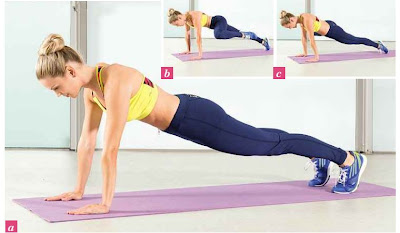You have probably heard it before, but we’ll say it again–the plank is one of the best abdominal
exercises ever. It’ll help flatten your abs, improve your posture and work your core, which helps stabilise your body and prevent injury.It also works your arms, shoulders and upper back. Keep challenging your self and stay motivated with some of our favourite variations.Enjoy!!
 |
| Best Plank Position |
Classic Plank
TIME:60SECONDS
BENEFITS: Helps build a strong core, while improving your posture and working your arms,
shoulders and back.
HOW TO DO IT:
● Starting at the top of a push-up position,bend your elbows and lower your self down until you can shift your weight from your hands to your forearms– your body should form a straight line,as above.
● Brace your abs(imagine someone’s about to punch you in the stomach), squeeze your glutes and hold.
SIDE PLANK
 |
| Side Plank |
TIME: 30 seconds each side
BENEFITS: Challenges your core from a different
angle while working your obliques and shoulders.
● Lie on your right side with your legs and feet stacked.
● Shift your weight on to your right fore arm. Open your chest and place your left hand on your hip.
● Lift your right foot and place it on top of your left leg, keeping your right elbow and shoulder in a straight line.
● With each breath,contract your abs a little bit harder.
Spider (WO) Man PLANK
REPS: 10 (5 each side)
 |
| Spider Plank |
BENEFITS: Works your deep core muscles and obliques
(at the sides of your waist
to cinch you in).
● Start in the top of a press-up position with your core braced and your body in a straight line from your head to your ankles (a).
● Lift your left foot off the floor and slowly bring your knee in towards your left elbow, as close as you can (b).
● Pause, then place your foot back on the floor where it started.
● Repeat with your right leg(c)
UP , DOWN PLANK
REPS: 10 each arm
BENEFITS: Tests your co-ordination and core
 |
| Up Down Plank |
stability as you work extra
hard to keep your body in a
straight line during the move.
● Start in a press-up position with your arms and legs straight and your hands under your shoulders(a).
● Draw your navel toward your spine to engage your core and avoid straining your lower back.
● Keeping your torso parallel to the floor, lower your right fore arm to the mat (b), then the left (c), so you’re in an elbow plank.
● Next,step your right hand back on to the mat (d), then the left, pushing your self back up to start position (e).
● Try to avoid swaying your torso from side to side through out this move
You can do the plank any time, anywhere! Try it next to your bed when you wake up or during the ad breaks in your favourite TV show










